What should you recommend to prevent users outside the Litware on-premises network from accessing the analytical data store?
What should you do to improve high availability of the real-time data processing solution?
Which Azure Data Factory components should you recommend using together to import the daily inventory data from the SQL server to Azure Data Lake Storage? To answer, select the appropriate options in the answer area.
NOTE: Each correct selection is worth one point.
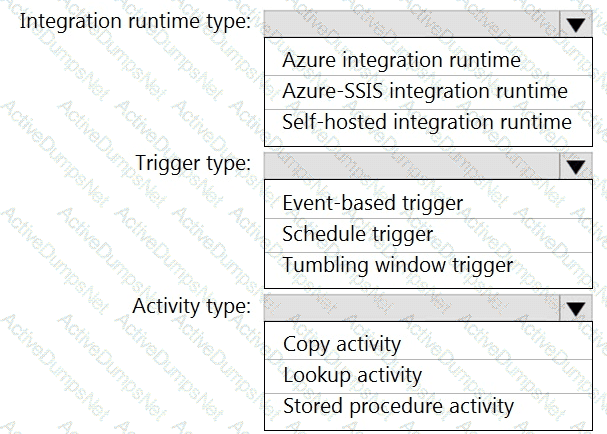
What should you recommend using to secure sensitive customer contact information?
You need to integrate the on-premises data sources and Azure Synapse Analytics. The solution must meet the data integration requirements.
Which type of integration runtime should you use?
You need to implement versioned changes to the integration pipelines. The solution must meet the data integration requirements.
In which order should you perform the actions? To answer, move all actions from the list of actions to the answer area and arrange them in the correct order.
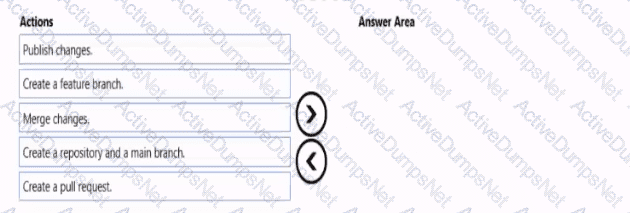
You need to design a data storage structure for the product sales transactions. The solution must meet the sales transaction dataset requirements.
What should you include in the solution? To answer, select the appropriate options in the answer area.
NOTE: Each correct selection is worth one point.

You need to ensure that the Twitter feed data can be analyzed in the dedicated SQL pool. The solution must meet the customer sentiment analytics requirements.
Which three Transaction-SQL DDL commands should you run in sequence? To answer, move the appropriate commands from the list of commands to the answer area and arrange them in the correct order.
NOTE: More than one order of answer choices is correct. You will receive credit for any of the correct orders you select.

You need to implement the surrogate key for the retail store table. The solution must meet the sales transaction
dataset requirements.
What should you create?
You need to design a data ingestion and storage solution for the Twitter feeds. The solution must meet the customer sentiment analytics requirements.
What should you include in the solution? To answer, select the appropriate options in the answer area
NOTE: Each correct selection b worth one point.

You need to design the partitions for the product sales transactions. The solution must meet the sales transaction dataset requirements.
What should you include in the solution? To answer, select the appropriate options in the answer area.
NOTE: Each correct selection is worth one point.
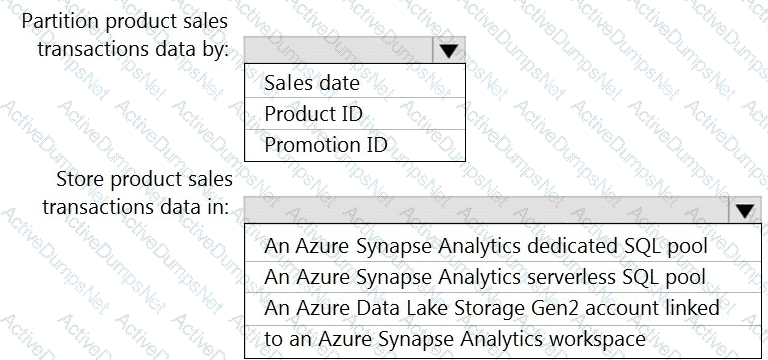
You need to design a data retention solution for the Twitter feed data records. The solution must meet the customer sentiment analytics requirements.
Which Azure Storage functionality should you include in the solution?
You need to implement an Azure Synapse Analytics database object for storing the sales transactions data. The solution must meet the sales transaction dataset requirements.
What solution must meet the sales transaction dataset requirements.
What should you do? To answer, select the appropriate options in the answer area.
NOTE: Each correct selection is worth one point.

You need to design an analytical storage solution for the transactional data. The solution must meet the sales transaction dataset requirements.
What should you include in the solution? To answer, select the appropriate options in the answer area.
NOTE: Each correct selection is worth one point.
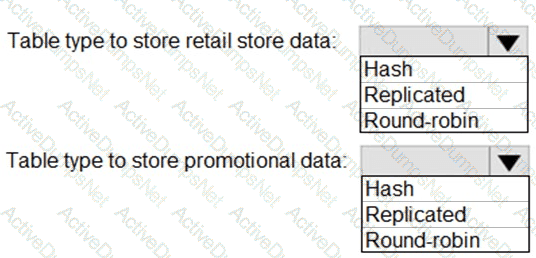
You use Azure Stream Analytics to receive data from Azure Event Hubs and to output the data to an Azure Blob Storage account. You need to output the count of records received from the last five minutes every minute. Which windowing function should you use?
Note: This question is part of a series of questions that present the same scenario. Each question in the series contains a unique solution that might meet the stated goals. Some question sets might have more than one correct solution, while others might not have a correct solution.
After you answer a question in this section, you will NOT be able to return to it. As a result, these questions will not appear in the review screen.
You plan to create an Azure Databricks workspace that has a tiered structure. The workspace will contain the following three workloads:
A workload for data engineers who will use Python and SQL.
A workload for jobs that will run notebooks that use Python, Scala, and SOL.
A workload that data scientists will use to perform ad hoc analysis in Scala and R.
The enterprise architecture team at your company identifies the following standards for Databricks environments:
The data engineers must share a cluster.
The job cluster will be managed by using a request process whereby data scientists and data engineers provide packaged notebooks for deployment to the cluster.
All the data scientists must be assigned their own cluster that terminates automatically after 120 minutes of inactivity. Currently, there are three data scientists.
You need to create the Databricks clusters for the workloads.
Solution: You create a Standard cluster for each data scientist, a High Concurrency cluster for the data engineers, and a High Concurrency cluster for the jobs.
Does this meet the goal?
You have an Azure subscription that contains the following resources:
An Azure Active Directory (Azure AD) tenant that contains a security group named Group1
An Azure Synapse Analytics SQL pool named Pool1
You need to control the access of Group1 to specific columns and rows in a table in Pool1.
Which Transact-SQL commands should you use? To answer, select the appropriate options in the answer area.
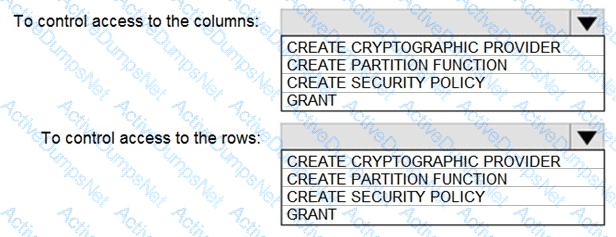
You have an Azure Synapse Analytics workspace that contains three pipelines and three triggers named Trigger 1. Trigger2, and Tiigger3.
Trigger 3 has the following definition.


You have an Azure subscription that contains the resources shown in the following table.

You need to read the files in storage1 by using ad-hoc queries and the openrowset function. The solution must ensure that each rowset contains a single JSON record.
To what should you set the format option of the openrowset function?
You have several Azure Data Factory pipelines that contain a mix of the following types of activities.
* Wrangling data flow
* Notebook
* Copy
* jar
Which two Azure services should you use to debug the activities? Each correct answer presents part of the solution NOTE: Each correct selection is worth one point.
You use Azure Data Lake Storage Gen2 to store data that data scientists and data engineers will query by using Azure Databricks interactive notebooks. Users will have access only to the Data Lake Storage folders that relate to the projects on which they work.
You need to recommend which authentication methods to use for Databricks and Data Lake Storage to provide the users with the appropriate access. The solution must minimize administrative effort and development effort.
Which authentication method should you recommend for each Azure service? To answer, select the appropriate options in the answer area.
NOTE: Each correct selection is worth one point.
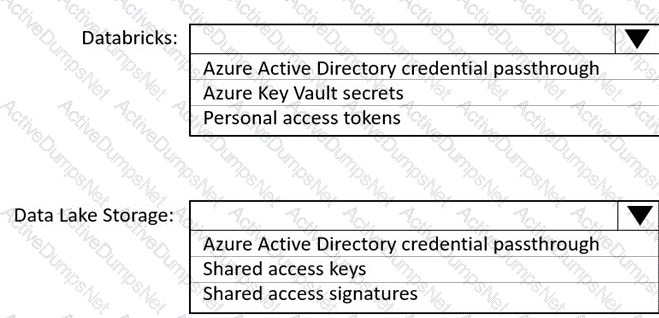
You have an Azure subscription that contains an Azure Synapse Analytics dedicated SQL pool.
You need to identify whether a single distribution of a parallel query takes longer than other distributions.
You have an Azure subscription.
You plan to build a data warehouse in an Azure Synapse Analytics dedicated SQL pool named pool1 that will contain staging tables and a dimensional model. Pool1 will contain the following tables.
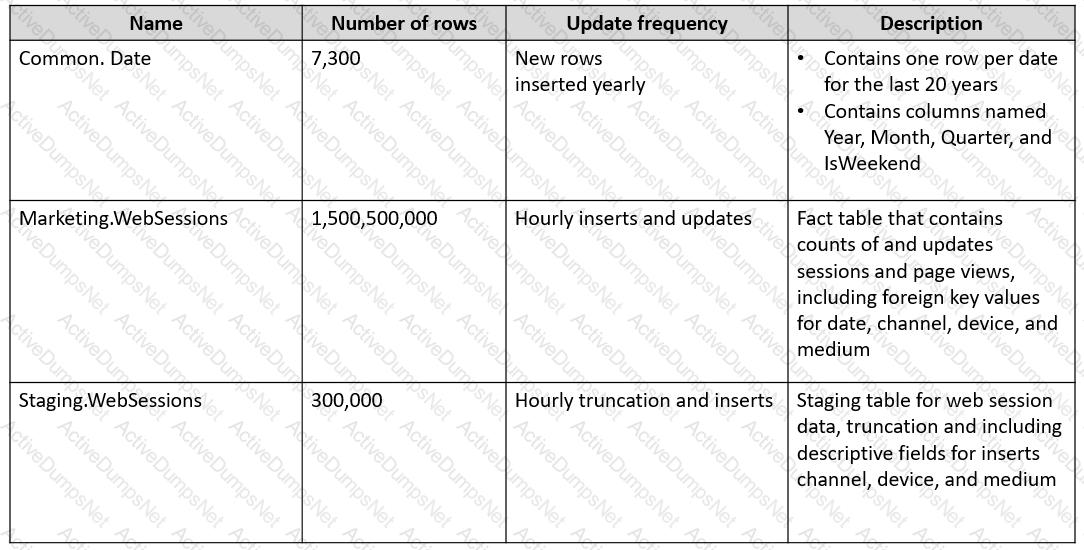
You need to design the table storage for pool1. The solution must meet the following requirements:
Maximize the performance of data loading operations to Staging.WebSessions.
Minimize query times for reporting queries against the dimensional model.
Which type of table distribution should you use for each table? To answer, drag the appropriate table distribution types to the correct tables. Each table distribution type may be used once, more than once, or not at all. You may need to drag the split bar between panes or scroll to view content.
NOTE: Each correct selection is worth one point.

You have an Azure subscription that contains an Azure Synapse Analytics workspace named Workspaces a Log Analytics workspace named Workspace2, and an Azure Data Lake Storage Gen2 container named Container1.
Workspace1 contains an Apache Spark job named Job1 that writes data to Container1. Workspace1 sends diagnostics to Workspace2.
From Synapse Studio, you submit Job1.
What should you use to review the LogQuery output of the job?
You have Azure Data Factory configured with Azure Repos Git integration. The collaboration branch and the publish branch are set to the default values.
You have a pipeline named pipeline 1.
You build a new version of pipeline1 in a branch named feature 1.
From the Data Factory Studio, you select Publish
The source code of which branch will be built, and which branch will contain the output of the Azure Resource Manager (ARM) template? To answer, select the appropriate options in the answer area.

You have an Azure Synapse Analytics dedicated SQL pool.
You run PDW_SHOWSPACEUSED(dbo,FactInternetSales’); and get the results shown in the following table.
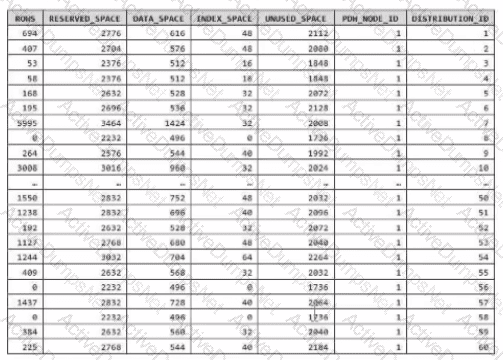
Which statement accurately describes the dbo,FactInternetSales table?
You have an Azure Data Lake Storage account that contains a staging zone.
You need to design a dairy process to ingest incremental data from the staging zone, transform the data by executing an R script, and then insert the transformed data into a data warehouse in Azure Synapse Analytics.
Solution: You use an Azure Data Factory schedule trigger to execute a pipeline that copies the data to a staging table in the data warehouse, and then uses a stored procedure to execute the R script.
Does this meet the goal?
You have an Azure Synapse Analytics dedicated SQL pool named Pool1 that contains an external table named Sales. Sales contains sales data. Each row in Sales
contains data on a single sale, including the name of the salesperson.
You need to implement row-level security (RLS). The solution must ensure that the salespeople can access only their respective sales.
What should you do? To answer, select the appropriate options in the answer area.
NOTE: Each correct selection is worth one point.
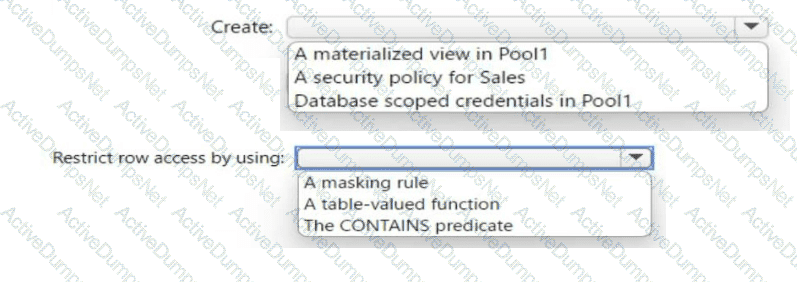
You have an Azure Stream Analytics job that receives clickstream data from an Azure event hub.
You need to define a query in the Stream Analytics job. The query must meet the following requirements:
Count the number of clicks within each 10-second window based on the country of a visitor.
Ensure that each click is NOT counted more than once.
How should you define the Query?
You are implementing a batch dataset in the Parquet format.
Data tiles will be produced by using Azure Data Factory and stored in Azure Data Lake Storage Gen2. The files will be consumed by an Azure Synapse Analytics serverless SQL pool.
You need to minimize storage costs for the solution.
What should you do?
You have a SQL pool in Azure Synapse.
You plan to load data from Azure Blob storage to a staging table. Approximately 1 million rows of data will be loaded daily. The table will be truncated before each daily load.
You need to create the staging table. The solution must minimize how long it takes to load the data to the staging table.
How should you configure the table? To answer, select the appropriate options in the answer area.
NOTE: Each correct selection is worth one point.
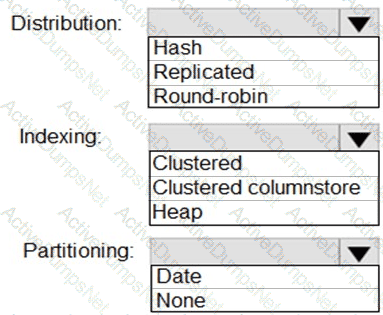
You have an Azure Synapse Analytics serverless SQ1 pool.
You have an Azure Data Lake Storage account named aols1 that contains a public container named container1 The container 1 container contains a folder named folder 1.
You need to query the top 100 rows of all the CSV files in folder 1.
How shouk1 you complete the query? To answer, drag the appropriate values to the correct targets. Each value may be used once, more than once, or not at all. You may need to drag the split bar between panes or scroll to view content.
NOTE Each correct selection is worth one point.

You have an Azure Databricks workspace that contains a Delta Lake dimension table named Tablet. Table1 is a Type 2 slowly changing dimension (SCD) table. You need to apply updates from a source table to Table1. Which Apache Spark SQL operation should you use?
Note: This question is part of a series of questions that present the same scenario. Each question in the series contains a unique solution that might meet the stated goals. Some question sets might have more than one correct solution, while others might not have a correct solution.
After you answer a question in this scenario, you will NOT be able to return to it. As a result, these questions will not appear in the review screen.
You have an Azure Storage account that contains 100 GB of files. The files contain text and numerical values. 75% of the rows contain description data that has an average length of 1.1 MB.
You plan to copy the data from the storage account to an Azure SQL data warehouse.
You need to prepare the files to ensure that the data copies quickly.
Solution: You modify the files to ensure that each row is more than 1 MB.
Does this meet the goal?
You are designing a fact table named FactPurchase in an Azure Synapse Analytics dedicated SQL pool. The table contains purchases from suppliers for a retail store. FactPurchase will contain the following columns.
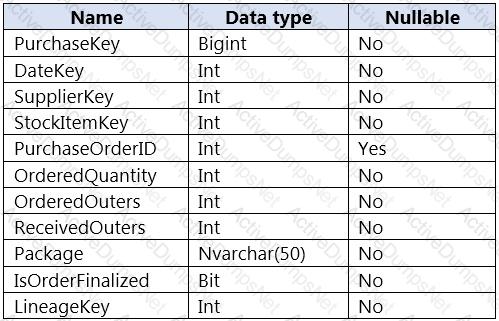
FactPurchase will have 1 million rows of data added daily and will contain three years of data.
Transact-SQL queries similar to the following query will be executed daily.
SELECT
SupplierKey, StockItemKey, COUNT(*)
FROM FactPurchase
WHERE DateKey >= 20210101
AND DateKey <= 20210131
GROUP By SupplierKey, StockItemKey
Which table distribution will minimize query times?
You need to implement a Type 3 slowly changing dimension (SCD) for product category data in an Azure Synapse Analytics dedicated SQL pool.
You have a table that was created by using the following Transact-SQL statement.
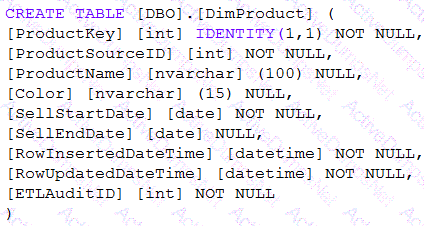
Which two columns should you add to the table? Each correct answer presents part of the solution.
NOTE: Each correct selection is worth one point.